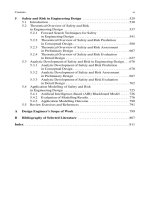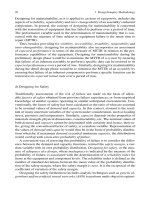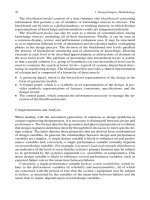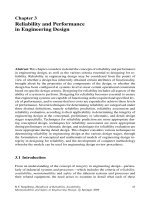Handbook of Reliability, Availability, Maintainability and Safety in Engineering Design - Part 30 ppsx
Bạn đang xem bản rút gọn của tài liệu. Xem và tải ngay bản đầy đủ của tài liệu tại đây (502.15 KB, 10 trang )
3.4 Application Modelling of Reliability and Performance in Engineering Design 273
Fig. 3.77 Hazards criticality analysis logistics worksheet
Distributed control systems are dedicated systems used to control processes that
are continuous or batch-oriented. A DCS is normally connected to sensors and ac-
tuators, and uses set-point control to control the flow of material through the plant.
The most common example is a set-point control loop consisting of a pressure sen-
sor, controller, and control valve. Pressure or flow measurements are transmitted to
the controller, usually through the aid of a signal conditioning input/output (I/O)
device. When the measured variable reaches a certain point, the controller instructs
a valve or actuation device to open or close until the flow process reaches the desired
set point. Programmable logic controllers (PLCs) have recently replaced DCSs, es-
pecially with SCADA systems.
A programmable logic controller (PLC), or programmable controller, is a digital
computer used for automation of industrial processes. Unlike general-purpose con-
trollers, the PLC is designed for multiple inputs and output arrangements, extended
temperature ranges, immunity to electrical noise, and resistance to vibration and im-
pact. PLC applications are typically highly customised systems, compared to spe-
cific custom-built controller design such as with DCSs. However, PLCs are usually
configured with only a few analogue control loops; where processes require hun-
dreds or thousands of loops, a DCS would rather be used. Data are obtained through
a connected supervisory control and data acquisition (SCADA) system connected
274 3 Reliability and Performance in Engineering Design
Fig. 3.78 Hazards criticality analysis logistics spreadsheet
to the DCS or PLC. The term SCADA usually refers to centralised systems that
monitor and control entire plant, or integrated complexes of systems spread over
large areas. Most site control is performed autom atically by remote terminal units
(RTUs) or by programmable logic controllers (PLCs). Host control functions are
usually restricted to basic site overriding or supervisory level intervention. For ex-
ample, a PLC may control the flow of cooling water through part of a process, such
as the reverse jet scrubber,but the SCADA system allows operators to changethe set
points for the flow, and enables alarm conditions, such as loss of flow and high tem-
perature, to be displayed and recorded. The feedback control loop passes through
the RTU or PLC, while the SCADA system monito rs the overall performance.
Using the SCADA data, a criticality ranking of the systems and their related as-
semblies was determined, which revealed that the highest ranking systems were the
drying tower, hot gas feed, reverse jet scrubber, final absorption tower, and IPAT
SO3 cooler. More specifically, the highest ranking critical assemblies and their re-
lated components of these systems were identified as the drying tower blowers’
shafts, bearings (PLF) and scroll housings (TLF), the hot gas feed induced draft
fan (PFC), the reverse jet scrubber’s acid spray nozzles (TLF), the final absorption
tower vessel and cooling fan guide vanes (TLF), and the IPAT SO3 cooler’s cool-
ing fan control vanes (TLF). These results were surprising, and further analysis was
3.4 Application Modelling of Reliability and Performance in Engineering Design 275
Fig. 3.79 Typical data accumulated by the installation’s DCS
required to compare the results with the RAMS analysis design specifications. De-
spite an initial anticipation o f non-correlation of the FMECA results with the design
specifications, due to some modifications during construction, the RAM analysis
appeared to be relatively accurate. However, further comparative analysis needed
to be considered with each specific system hierarchy relating to the highest ranked
systems, namely the drying tower, hot gas feed, reverse jet scrubber, final absorption
tower, and I PAT SO3 cooler.
According to the design integrity methodologyin the RAMS analysis, the design
specification FMECA for the drying tower ind icates an estimated criticality value
of 32 for the no.1 SO2 blower scroll housing (TLF), which is the highest estimated
value resulting in the topmost criticality ranking. The no.1 SO2 blower shaft seal
(PLF) has a criticality value of 24, the shaft and bearings (PLF) a criticality value of
10, and the impeller (PLF) a criticality value of 7.5. Fr om th e FMECA case study
extract given in Table 3.25, the topmost criticality ranking was determined as the
drying tower blowers’ shafts and bearings (PLF), and scroll housings (TLF) as 5th
and 6th. The drying tower blowers’ shaft seals (TLF) featured 9th and 10th, and the
impellers did not feature at all.
Although the correlation between the RAMS analysis design specifications illus-
trated in Fig. 3.80 and the results of the case study is not quantified, a qualitative
276 3 Reliability and Performance in Engineering Design
Table 3.24 Acid plant failure modes and effects analysis (ranking on criticality)
System Assembly Component Failure
description
Failure
mode
Failure effects Failure
consequences
Failure causes
Hot gas
feed
Hot gas
(ID) fan
Excessiv e
vibration
PFC HotgasIDfanwouldtriponhigh
vibration, as detected by any of four fitted
vibration switches. Results in all gas
directed to main stack
Production Dirt accumulation on impeller due to
excessi ve dust from ESPs
Reverse
jet
scrubber
Re verse jet
scrubber
W/acid
spray
nozzles
Fails to
deliver
spray
TLF Prevents the distribution of acid
uniformly in order to provide protection
to the RJS and cool the gases. Hot gas
temp. exiting in RJS will be detected and
shut down plant
Production Nozzle blocks due to foreign materials
in the weak acid supply or f alls off due
to incorrect installation
Drying
tower
No.2 SO2
blower
Shaft &
bearings
Fails to
contain
PLF No immediate effect but can result in
equipment damage
Production Leakage through seals due to breather
blockage or seal joint deterioration
Drying
tower
No.1 SO2
blower
Shaft &
bearings
Excessiv e
vibration
PFC Can result in equipment damage and loss
of acid production
Production Loss of balance due to impellor
deposits or permanent loss of blade
material by corrosion/erosion
Drying
tower
Drying
tower
Restricted
gas flow
PLF Increased loading on SO2 blower Production Mist pad blockage due to ESP
dust/chemical accumulation
Drying
tower
No.1 SO2
blower
Scroll
housing
Fails to
contain
TLF No effect immediate effect other than
safety problem due to gas emission
Health hazard Cracked housing due to operation
above design temperature limits or
restricted expansion
Drying
tower
No.1 SO2
blower
Shaft seal Fails to
contain
TLF No effect immediate effect other than
safety problem due to gas emission
Health hazard Carbon ring wear-out due to rubbing
friction between shaft sleeve and
carbon surface
3.4 Application Modelling of Reliability and Performance in Engineering Design 277
Table 3.24 (continued)
System Assembly Component Failure
description
Failure
mode
Failure effects Failure
consequences
Failure causes
Final
absorb.
tower
Final
absorb.
tower
Fails to
absorb SO3
from the gas
stream
TLF Will result in poor stack appearance, loss
in acid production and plant shutdown
due to environmental reasons
Environment Loss of absorbing acid flo w or non
uniform distribution of flow due to
absorbing acid trough or header
collapsing
Final
absorb.
tower
FAT cool.
fan piping
Inlet guide
vanes
Vanes fail to
rotate
TLF Loss of flow control leading to loss of
ef ficienc y of the FAT leading to possible
SO2 emissions. This will lead to plant
shutdown if the emissions are excessive
or if temp. is >220
◦
C
Environment Seized adjustment ring due to roller
guides worn or damaged due to lack of
lubrication
Final
absorb.
tower
FAT cool.
fan piping
Inlet guide
vanes
Vanes fail to
rotate
TLF Loss of flow control leading to loss of
ef ficienc y of the FAT leading to possible
SO2 emissions. This will lead to plant
shutdown if the emissions are excessive
or if temp. is >220
◦
C
Environment Seized vane stem sleeve due to
deteriorated shaft stem sealing ring and
ingress of chemical deposits
Final
absorb.
tower
FAT cool.
fan piping
Inlet guide
vanes
Operation
outside
limits of
control
TLF Loss of flow control leading to loss of
ef ficienc y of the FAT leading to possible
SO2 emissions. This will lead to plant
shutdown if the emissions are excessive
or if temp. is >220
◦
C
Environment Loose or incorrectly adjusted vane link
pin due to incorrect installation process
or over-stroke condition
I/P
absorb.
tower
I/PASS
absorb.
tower
Fails to
absorb SO3
from the gas
stream
TLF Will result in additional loading of
converter 4th pass and final absorbing
tower with possible stack emissions
Environment Loss of absorbing acid flo w due to
absorbing acid trough or header
collapsing
278 3 Reliability and Performance in Engineering Design
Table 3.24 (continued)
System Assembly Component Failure
description
Failure
mode
Failure effects Failure
consequences
Failure causes
Drying
tower
Drying
tower
Fails to
remove
moisture
from the gas
stream
TLF Will result in blower vibration problems,
deterioration of catalyst and loss of acid
production
Quality Damage, blockage or dislodged mist
pad due to high temp./excessive inlet
gas flow, or gas quality
Drying
tower
Drying
tower
Fails to
remove
moisture
from the gas
stream
TLF Will result in blower vibration problems,
deterioration of catalyst and loss of acid
production
Quality Damage, blockage or dislodged mist
pad due to improper installation of
filter pad retention ring
IPAT
SO3
cooler
SO3 cool.
fan piping
Inlet guide
vanes
Vanes fail to
rotate
TLF Loss of IPAT efficiency due to poor
temperature control of the gas stream.
Temperature control loop would cut gas
supply if gas discharge temperature at
IPAT cooler too high
Quality Seized adjustment ring due to roller
guides worn or damaged due to lack of
lubrication
IPAT
SO3
cooler
SO3 cool.
fan piping
Inlet guide
vanes
Vanes fail to
rotate
TLF Loss of IPAT efficiency due to poor
temperature control of the gas stream.
Temperature control loop would cut gas
supply if gas discharge temperature at
IPAT cooler too high
Quality Seized vane stem sleeve due to worn
shaft stem sealing ring and ingress of
chemical deposits
IPAT
SO3
cooler
SO3 cool.
fan piping
Inlet control
vanes
Operation
outside
limits of
control
TLF Loss of IPAT efficiency due to poor
temperature control of the gas stream.
Temperature control loop would cut gas
supply if gas discharge temperature at
IPAT cooler too high
Quality Loose or incorrectly adjusted vane link
pin due to incorrect installation process
or over-stroke condition
3.4 Application Modelling of Reliability and Performance in Engineering Design 279
Table 3.25 Acid plant failure modes and effects criticality analysis
System Assembly Component Failure
consequences
Probability Failures/
year
Severity Risk Crit.
value
Failure
cost/year
Crit. rate Fail cost
Drying to wer No.1 SO2 blower Shaft & bearings Production 100% 12 5 5.0 60.0 $287,400 High crit. High cost
Drying to wer No.2 SO2 blower Shaft & bearings Production 100% 12 5 5.0 60.0 $287,400 High crit. High cost
Hot gas feed Hot gas (ID) fan Production 100% 12 4 4.0 48.0 $746,400 High crit. High cost
Re verse jet
scrubber
Re verse jet
scrubber
W/acid spray
nozzles
Production 100% 6 6 6.0 36.0 $465,000 High crit. High cost
Drying tower No.1 SO2 blower Scroll housing Health hazard 80% 4 10 8.0 32.0 $1,235,600 High crit. High cost
Drying tower No.2 SO2 blower Scroll housing Health hazard 80% 4 10 8.0 32.0 $1,235,600 High crit. High cost
Drying to wer No.1 SO2 blower Shaft & bearings Production 100% 7 4 4.0 28.0 $449,400 High crit. High cost
Drying to wer No.2 SO2 blower Shaft & bearings Production 100% 7 4 4.0 28.0 $449,400 High crit. High cost
Drying tower No.1 SO2 blower Shaft seal Health hazard 80% 3 10 8.0 24.0 $366,300 High crit. High cost
Drying tower No.2 SO2 blower Shaft seal Health hazard 80% 3 10 8.0 24.0 $366,300 High crit. High cost
Drying tower Drying tower Quality 80% 4 7 5.6 22.4 $620,200 High crit. High cost
IPAT SO3
cooler
SO3 cool. f an
piping
Inlet guide vanes Quality 100% 3 7 7.0 21.0 $219,600 High crit. High cost
IPAT SO3
cooler
SO3 cool. f an
piping
Inlet control
vanes
Quality 100% 3 7 7.0 21.0 $215,100 High crit. High cost
I/P absorb.
tower
I/PASS absorb.
tower
Environment 60% 4 8 4.8 19.2 $915,600 High crit. High cost
Final absorb.
tower
FAT cool. fan
piping
Environment 80% 3 8 6.4 19.2 $216,600 High crit. High cost
280 3 Reliability and Performance in Engineering Design
Fig. 3.80 Design specification FMECA—drying tower
assessment of the design integrity methodology of the RAMS analysis can be de-
scribed as accurate.
The RAMS analysis design specification FMECA for the hot gas feed indicates
an estimated criticality value of 6 for both the SO2 gas duct pressure transmitter a nd
temperature transmitter. From the FMECA case study extract given in Table 3 .25,
the criticality for the hot gas feed’s induced draft fan (PFC) ranked 3rd out of the
topmost 15 critical items of equipment, whereas the design specification FMECA
ranked the induced draft fan (PFC) as a mere 3, which is not illustrated in Fig. 3.81.
The hot gas feed’s SO2 gas duct pressure and temperature tran smitters, illustrated
in Fig. 3.81, h ad a criticality rank of 6, whereas they do not feature in the FMECA
case study extract given in Table 3.25.
Although this does indicate some vulnerability of accuracy in the assessment and
evaluation of design integrity at the lower levels of the systems breakdown structure
(SBS), especially with respect to an assessment of the critical failure mode, the
identification of the hot gas feed induced draft fan as a h igh failure critical and high
cost critical item of equipment is valid.
The RAMS analysis design specification FMECA for the reverse jet scrubber
indicates an estimated criticality value of 6 for both the RJS pumps’ pressure indi-
cators. From the FMECA case study extract given in Table 3.25, the criticality for
3.4 Application Modelling of Reliability and Performance in Engineering Design 281
Fig. 3.81 Design specification FMECA—hot gas feed
the reverse jet scrubber’s acid spray nozzles (TLF) ranked 4th out of the topmost
15 critical items of equipment, whereas the design specification FMECA ranked
the acid spray nozzles (TLF) as 4.5, which is not illu strated in Fig. 3.82. Similar
to the hot gas f eed system, this again indicates some vulnerability of accuracy in
the assessment and evaluation of design integrity at the lower levels of the systems
breakdown structure (SBS), especially with respect to an assessment of the critical
failure mode.
The identification of the reverse jet scrubber’s pumps as a high failure critical
item of equipment (with respect to pressure instrumentation), illustrated in Fig. 3.82,
is valid, as the RJS pumps have a reliable design configuration of 3-up with two
operational and one standby.
The RAMS analysis design specification FMECA for the final absorption tower
indicates an estimated criticality value of 2.475, as illustrated in Fig. 3.83, which
gives a criticality rating of medium criticality. The highest criticality for components
of the final absorption tower system is 4.8, which is for the final absorption tower
temperature instrument loop. From the FMECA case study criticality ranking given
in Table 3.25, the final absorption tower ranked 15th out of the topmost 15 critical
items of equipment, whereas the design specification FMECA does not list the final
absorption tower as having a high criticality.
282 3 Reliability and Performance in Engineering Design
Fig. 3.82 Design specification FMECA—reverse jet scrubber
Similar to the hot gas feed system and the reverse jet scrubber system, this once
more indicates some vulnerability of accuracy in the assessment and evaluation of
design integrity at the lower levels of the systems breakdown structure (SBS). How-
ever, the identification of the final absorption tower as a critical system in the RAMS
design specification was verified by an evaluation of the plant’s failure data.
b) Failure Data Analysis
Failure data in the form of time (in days) before failure of the critical systems (dry-
ing tower, hot gas feed, reverse jet scrubber, final absorption tower, and IPAT SO3
cooler) were accumulated over a period of 2 months. These data are given in Ta-
ble 3.26, which shows acid plant failure data (repair time RT and time before failure
TBF) obtained from the plant’s distributed control system.
A Weibull distribution fit to the data produces the following results:
Acid plant failure data statistical analysis
Number of failures = 72
Number of suspensions = 0









